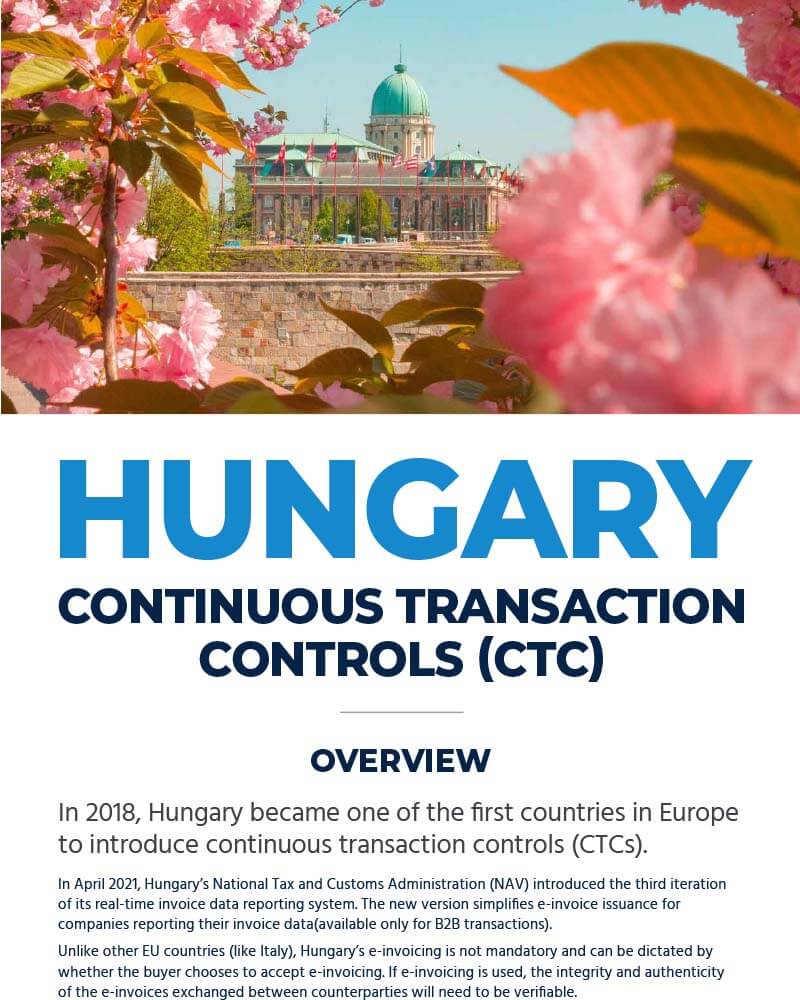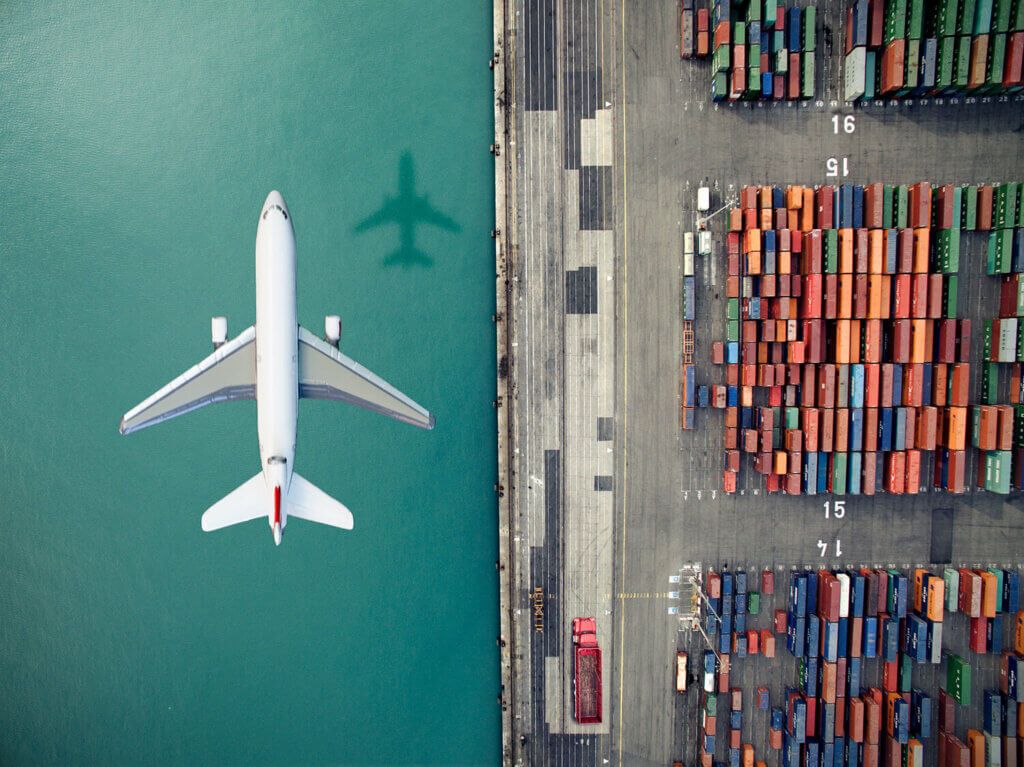
INFOGRAPHIC
Hungary’s CTC Requirements
Understand more about Hungary’s NAV system, how to file invoices, when businesses are required to comply and how Sovos can help.
In 2018, Hungary established a legal framework requiring taxpayers to use a designed schema to report invoice data to the tax authority (NAV) in real-time for domestic transactions above a minimum VAT amount.
Due to the success of this measure, the scope of the mandate has been extended to include a wider range of transactions, and the earlier thresholds have been abolished. The impact of the mandate is now broadly felt in Hungary where all transactions between domestic taxable persons must be reported to the NAV, regardless of the amount of VAT accounted.


1 July 2018: Mandate applies to all taxable persons to report invoice data in real-time to the National Custom and Tax administration of Hungary for domestic transactions with a minimum VAT amount of 100,000 HUF.
1 July 2020: The VAT threshold was abolished and all domestic transactions between taxable persons in Hungary must be reported regardless of the VAT accounted.
1 January 2021: Reporting obligations include B2C invoice issue and B2B intra-community supplies and exports.
1 January- 31 March 2021: The Ministry of Finance granted a sanction-free three-month grace period to comply with new reporting obligations and to give businesses time to transfer from the current version (v 2.0 XSD) to the new version v3.0 XSD.
1 April 2021: Mandatory usage of the new version (v3.0 XSD) begins.
Failure to report the invoices in real-time could lead to an administrative penalty of up to 500,000 HUF per invoice not reported.
Additional penalties would apply for non-compliance with the invoicing software requirements.


As Hungary edges ever closer to CTC e-invoicing invoice clearance, Sovos enables businesses to stay up to date with the latest requirements and technical specifications so they can effectively connect with the NAV and honour their VAT compliance obligations.
France will implement mandatory B2B e-invoicing, as well as an e-reporting obligation. This mandate impacts all companies operating in France.
This new e-invoicing mandate is complex and introduces the continuous transaction controls (CTC) model.
Note: The Finance Law for 2024 has been officially adopted and published in the Official Gazette on 30 December 2023. Our blog, France: B2B E-Invoicing Mandate Postponed, is promptly updated whenever there are changes to the rollout of the French mandate.
France’s e-invoicing mandate, combined with the e-reporting obligation, provides the tax authorities with access to transaction data. This is to increase efficiency, cut costs and fight fraud.
Whether you are a buyer or supplier, the mandate’s effect on businesses and their operational processes, financial systems and people is extensive.
The France e-invoicing guide will explain:

Want to learn about the upcoming mandatory e-invoicing requirements in France? Download our ebook, France: A New Horizon – E-invoicing Mandate.
*The e-invoicing mandate does not apply to B2C and cross-border invoices. However, there is an obligation to report those transactions so the tax administration has full visibility.
E-invoicing: €15 per invoice, capped at €15,000 per year
E-reporting: €250 per transmission, capped at €45,000 per year
Sovos can help your business comply with the French mandate with a range of services:
Learn more about our scalable solution for France’s continuous transaction controls requirements

France’s e-reporting requirements are alongside the new e-invoicing mandate, with the reporting frequency based on the taxpayers’ VAT regime requirements.
France’s e-invoicing requirements come into effect during 2024-2026, depending on business size. All companies must be able to receive e-invoices under the new rules that come into effect on July 2024.
When directly transmitting to the centralised platform, the structure of the e-invoices can be UBL, CII or Factur-X (a mixed format).
E-invoices exchanged between two registered service providers can use any other structured format.
During a transitional period until December 2027, taxpayers may submit their invoices in an unstructured PDF format.
Transmission of all domestic B2B invoices must be through the central platform (Portail Public de Facturation – PPF) or via registered service providers connected to the platform (Partner Dematerialization Platforms – PDP).
There are a growing number of tax authorities that have implemented e-invoicing globally, including France, Italy, Saudi Arabia and India. There are also many countries working on implementing e-invoicing including Germany and Spain.
Italy was the first country in the region to introduce a clearance e-invoicing model with the Sistema di Interscambio (SdI) platform. Seeking to close one of Europe’s most significant VAT gaps, the government has steadily improved its Continuous Transaction Controls (CTC) system.
Beginning with B2G e-invoicing in 2014 and extending to cover domestic B2B and B2C e-invoices in 2019, Italy became the first EU country to make B2B e-invoicing mandatory through a clearance process.
This page will:
B2B e-invoicing in Italy applies to:
B2G e-invoicing in Italy applies to:

Sovos ensures compliance with all SdI e-invoicing and VAT requirements in Italy including CTC e-invoicing, reporting and e-archiving. All you need to do is work with us and you can use our solution that connects directly with the SdI.
Want to learn more about e-invoicing?
Download the 13th edition of Trends to learn about the global e-invoicing landscape
Eastern Europe is another region adopting e-invoicing. Find out more in our ebook, VAT Digitization in Eastern Europe

E-invoicing in Italy is mandatory for the majority of the B2B, B2C and B2G invoices. Suppliers performing activities classified as “Commercio al minute e attivitá assimilate” are exempt from the obligation of issuing e-invoices, unless their customers so request them; on the other hand, those suppliers are required to electronically transmit a daily aggregate report (It.: Scontrino Elettronico). Reporting of cross-border transactions through the SDI in the FatturaPA format is also mandatory.
The tax authority requires all invoices in the Fattura PA XML schema format. Transmission of e-invoices happens through the Sistema di Interscambio. E-invoices must be cleared by the tax authority. The Italian tax authority delivers the legal cleared e-invoice to the recipient.
With ease. Our solution connects securely with the SdI, freeing you from the burden of knitting together different systems and platforms.
The term conservazione sostitutiva refers to a long-term preservation process required for compliant archiving of e-invoices in Italy. E-invoices must be preserved after being archived by grouping them together in a so-called ‘package’, and providing that e-invoice package with a qualified digital signature or seal and a time reference.
This process must be completed no later than three months after the deadline for the submission of the annual fiscal declaration at the end of the fiscal year. E-invoice preservation is an integral feature of Sovos eArchive for invoices stored under Italian law.
While many governments and tax authorities are now on an e-Transformation journey, this trend began in Latin America in the early 2000s. Turkey followed suit a decade later when it began the digitization of its tax system.
Turkey is further along in its e-Transformation journey than most countries – including EU Member States, which are working towards digitization in their own way with the overarching VAT in the Digital Age initiative.
From e-invoicing to electronic self-employment receipts, Turkey now has a fully-fledged, established digital tax system with many moving parts. To understand Turkey’s e-Transformation, bookmark this page then read on.
CTC Type
E-invoice clearance with both parties registered on the portal
Network
Centralised – e-Fatura Portal delivers the e-invoices to Buyers for B2B transactions
Format
UBL-TR format
eSignature Requirement
Required – fiscal stamp or qualified electronic signature
Archiving requirement
10 years
CTC Type
E-invoice reporting (daily basis)
Network
Decentralised – e-Fatura Portal does not deliver e-arşiv invoices; it’s the taxpayers’ responsibility
Format
UBL-TR format or in a free format such as PDF and must also be available in paper form
eSignature Requirement
Required – fiscal stamp or qualified electronic signature
Turkey stepped up its tax system through digitization in 2012 to help important information be gathered and transmitted with ease and accuracy. It’s further ahead than many other countries, with a variety of electronic systems and documents mandated for many taxpayers – all starting with its e-Ledger obligation.
Turkey joined the eEurope+ initiative and moved fast to ensure it was keeping up with tax digitization efforts, relieving its entire economic ecosystem where information is concerned. The aims of such changes are to reduce VAT fraud, increase governmental access to and control of data, standardise financial and accounting processes and reduce errors.
Now effectively utilising electronic versions of invoices, ledgers, delivery notes, self-employed receipts and more, there are a lot of challenges for taxpayers to overcome to remain compliant amidst Turkey’s e-Transformation.
Turkey’s ambition to electronically transform its tax ecosystem required the development and implementation of many products and services. This presented taxpayers with new requirements and, subsequently, new challenges.
Here are the products and services in Turkey’s e-Transformation system:
e-Fatura is Turkey’s e-invoicing initiative. Mandated for companies with turnovers of over TRY 5 million, this obligation came into effect on 1 April 2014. There are also sector-based parameters for the nation’s e-invoicing mandate, ignoring the turnover threshold, qualifying the following for an electronic invoice obligation:
Turkey’s e-invoicing initiative is a clearance model and two-way application, with issued invoices needing to be in the UBL-TR format and archived for 10 years. Sovos’ e-invoice solution enables compliance with e-Fatura requirements.
e-Arşiv Fatura is Turkey’s e-arşiv invoice initiative. Taxpayers registered in the e-Fatura system must also issue e-Arşiv invoices, either in the UBL-TR format or in a free format such as PDF.
Real-time clearance is not conducted for the issuance of these invoices, though an e-Arşiv report must be submitted electronically to the tax authority by the end of the following day. e-Arşiv invoices are always created electronically but must be available in paper form unless the buyer agrees to receive the document electronically.
The Sovos e-Arşiv Invoice solution makes e-archive invoice compliance simple.
e-İrsaliye is Turkey’s e-WayBill initiative. The use of e-İrsaliye documents became obligatory for taxpayers that surpass the TRY 10 million revenue threshold on 1 July 2023, though those outside of the scope can voluntarily switch to electronic WayBill documents.
There are two types of paper waybills, namely shipment and transportation. e-İrsaliye largely replaces the shipment waybill.
Information required in this type of e-document includes:
Legally, there is no difference between paper waybills and eWayBills, though the electronic version requires both parties to be registered in the national system.
e-Defter is Turkey’s e-Ledger initiative. The Turkish tax authorities made the e-Ledger application mandatory for e-invoice users and taxpayers, subject to independent audit, in 2015.
These e-documents must be prepared in XBRL-GL format and include specific information in standard XML format – all signed with a financial seal. In addition to producing e-ledgers, taxpayers are required to create a ledger summary which is to be sent monthly to the TRA and archived for 10 years.
Electronic ledgers reduce the time it takes to collect data, save costs associated with the notarization process and ensure compliance with tax processes.
e-Mutabakat is Turkey’s e-Reconciliation initiative. Reconciliation is the communication between accounts to mutually agree on the debit and credit between companies that are part of an agreement.
Turkey’s tax authority has ruled that companies are obliged to make reconciliations at particular times. The last day of the year is typically the day when the account between two parties will be closed unless an agreement or legal requirement states otherwise.
The BA-BS web application developed by the TRA for e-Reconciliation enables taxpayers to compare current agreements and unbalanced agreements before electronic submission of the BA-BA forms.
e-Müstahsil Makbuzu is Turkey’s e-Producer Receipt initiative. This commercial e-document is issued by farmers or wholesalers to keep a record of the products they buy from farmers that don’t bookkeep.
Taxpayers that are obliged to issue producer receipts have had to issue electronic versions of the document, known as e-Müstahsil Makbuzu, since 1 July 2020. However, fruit and vegetable brokers or merchants have been required to issue e-Producer Receipts since 1 January 2020.
Those obliged to utilise e-Producer Receipts may be outside of the scope of e-Fatura, e-Arşiv Fatura and e-Defter requirements.
e-Serbest Meslek is Turkey’s e-Self-Employed Receipt (e-SMM) initiative. This obligation came into effect on 1 February 2020 and applies to all self-employed individuals, including:
e-SMM receipts can be created, submitted and reported electronically and carry the same legal weight as paper Self-Employment Receipts. They must be archived for 10 years.
While all the above are prominent e-documents, there are even more electronic documents in Turkey that you should know about. To learn more, read our e-documents overview.
E-Transformation includes many documents, each subject to specific thresholds and criteria based on their type. Additionally, certain documents are mandatory for particular sectors without any threshold criteria. E-invoicing is now mandatory for the majority of taxpayers, but it is important to understand which documents are required to be submitted to the tax authorities.
The TRA continues to announce new taxpayer groups in scope of the different document types, so it’s important that businesses stay up to date with the latest information to ensure they remain compliant.
Turkey’s tax transformation aimed to deliver benefits to both the government and taxpayers.
The e-Transformation initiative aims to produce the following benefits:
Turkey’s e-Transformation has impacted tax compliance, successfully implementing real-time transmission of important financial data.
With data automatically being populated in documents, it reduces the possibility of error via manual input and fraudulent invoices being submitted. The reduction of the VAT gap has been a driving force for many countries, including Turkey.
Eliminating paper, cartridge, shipping and archiving costs associated with paper invoices is also an advantage to businesses and government.
With over 16 document regulations, Turkey’s e-transformation system requirements are extensive and complex. Understanding which regulations apply and keeping up with the latest tax compliance guidelines is key.
Sovos provided the first global e-Transformation solution suite, helping businesses of all shapes and sizes to meet the demands of Turkish tax mandates. Our platform meets all the requirements, standards and formats defined by the Turkish Revenue Authority.
Organisations choose Sovos as their global compliance partner, partly due to the convenience of having a single vendor to aid compliance wherever and however they do business.
E-defter is not mandatory for voluntary e-fatura use.
A special integrator is an intermediary service provider authorised by the Turkish Revenue Administration. Special integrators have the authority to create electronic records on behalf of taxpayers.
UK and EU businesses need to rise to the VAT compliance challenge that Brexit poses. Now more than ever, it’s time to review supply chains and VAT records to trade with EU Member States. The transition period ended on 1 January 2021 and, as a result, trade between the UK and EU is now governed by the Free Trade Agreement announced on Christmas Eve 2020.
While many businesses prepared for Brexit’s impact on customs, many are yet to formulate a strategy to ensure VAT compliance. This is key to the success of any Brexit plan-of-action for the protection of supply chains, allowing companies to continue to trade confidently across Europe.



Businesses on both sides of the channel have much to do to prepare. We know the uncertainty Brexit generates is difficult to manage, so businesses need to be ready.
During this confusion, we can deliver clarity about the Brexit impact on your VAT compliance obligations.
From 1 July 2021, the EU introduced its e-Commerce VAT Package. The package replaces existing distance-selling rules and extends the Mini One Stop Shop (MOSS) into a wider-ranging One Stop Shop (OSS).
This represents a significant change to VAT rules for B2C supplies of goods and services, both as imports to the EU as well as intra-EU trading. The new, significantly lower pan-EU threshold of €10,000 (€0 for businesses established outside the EU) will impact most businesses who now need to account for VAT on more supplies.
Compared to the requirement for multiple VAT registrations under longstanding distance selling rules, with the OSS simplification, businesses may be able to register in one Member State and report all EU transactions through a single OSS return filed periodically. Payments are collected and distributed from the tax authority in this Member State to others where the VAT is due.
Read our free guide to the EU VAT e-Commerce package for more in-depth information.


The EU e-Commerce VAT Package introduced three schemes under OSS:
From 1 July 2021: The EU e-Commerce VAT Package came into effect. Whether or not a business decides to use the OSS schemes, they now have to account for VAT in all countries where they have a VAT liability. This may result in additional VAT registrations being required.
Failure to submit returns and make payments or notify the relevant tax authority of a significant change in supply chain (e.g. warehouse) on time can result in penalties. These can be imposed in each Member State where VAT is due or even expulsion from the scheme. Consequently, the penalisation of a single late return in multiple countries creates significant exposure to penalties.
Repeated noncompliance can lead to exclusion from the OSS schemes. The taxpayer then needs to register for VAT in all Member States where it has a VAT liability.
If expelled from the scheme, the two-year exclusion period could have significant commercial consequences as compliance costs are likely to increase and new VAT numbers will be required urgently.
Exclusion from IOSS may require the business to change its commercial arrangements with its customers which could have a significant impact on sales or increase compliance costs.

Implementing the changes required to comply with the EU e-Commerce VAT Package into your ERP system could take significant time and resources. Sovos can help ease the tax burden and help you prepare for and understand the right solution for your business.
Our large advisory team can help you navigate the complexities of modern VAT compliance.
Contact us to discuss how we can help your company prepare for the digital future of tax.